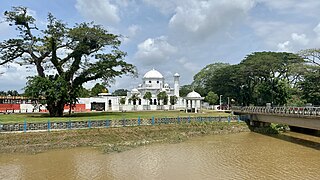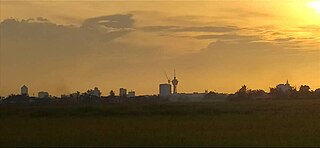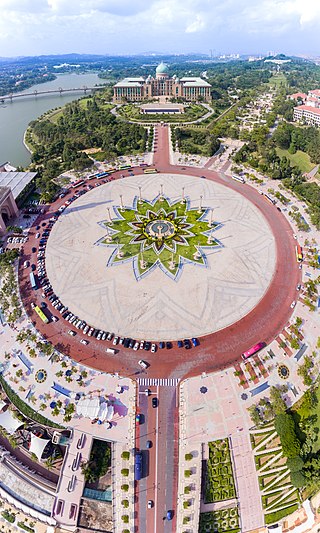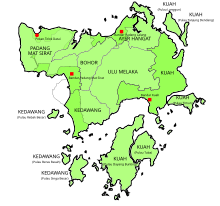
Kedah, also known by its honorific Darul Aman and historically as Queda, is a state of Malaysia, located in the northwestern part of Peninsular Malaysia. The state covers a total area of over 9,000 km2, and consists of a mainland portion and the Langkawi islands. The mainland has relatively flat terrain, which is used to grow rice, while Langkawi is composed of mostly of uninhabited islands.

Langkawi, officially known by its sobriquet Langkawi, the Jewel of Kedah, is a duty-free island and an archipelago of 99 islands located some 30 km off the coast of northwestern Malaysia and a few kilometres south of Ko Tarutao, adjacent to the Thai border. Politically, it is an administrative district of Kedah, with Kuah as its largest town. Pantai Cenang is the island's most popular beach and tourist area.

Kota Bharu, colloquially referred to as KB, is a town in Malaysia that serves as the state capital and royal seat of Kelantan. It is situated in the northeastern part of Peninsular Malaysia and lies near the mouth of the Kelantan River.

Kuala Terengganu, colloquially referred to as KT, is the administrative, economic and royal capital of the state of Terengganu, Malaysia. Kuala Terengganu is also the capital of Kuala Terengganu District. It is also the only royal capital among the nine royal states of the country to bear its state's name. Kuala Terengganu is located about 440 kilometres northeast of Kuala Lumpur on the East Coast of Peninsular Malaysia. The city is situated at the estuary of Terengganu River, facing the South China Sea.

Pekan is a town in Pekan District, Pahang, Malaysia. It is also the royal capital of the state. Its name comes from a flower, the Bunga Pekan. Pekan is also the name of the district the town is situated in, and a parliamentary constituency in its own right. It is the home of the state's royal family headed by Sultan Abdullah of Pahang. It is also the hometown of the second Prime Minister of Malaysia, Tun Abdul Razak Hussein, and his son, sixth prime minister Datuk Seri Najib Razak. Both were Pekan's Member of Parliament.

Alor Setar is the state capital of Kedah, Malaysia. It is the second-largest city in the state after Sungai Petani and one of the most-important cities on the west coast of Peninsular Malaysia. It is home to the third-tallest telecommunication tower in Malaysia, the Alor Setar Tower.

Bukit Bintang is the shopping and entertainment district of Kuala Lumpur, Malaysia. It encompasses Jalan Bukit Bintang and its immediate surrounding areas. The area has long been Kuala Lumpur's most prominent retail belt that is home to many landmark shopping centres, al-fresco cafés, bars, night markets, food street, mamak stalls as well as hawker-type eateries. This area is popular among tourists and locals, especially among the youths.

The Putra Square is a city square in Presint 1, Putrajaya, Malaysia. The square has been used for festivals such as the Malaysian Independence Day parade. The 300 meter circular Putra Square is bounded by Perdana Putra, Putra Mosque, Putra Bridge and the Promenade Shopping Mall.

The Muar River is a river which flows through the states of Negeri Sembilan and Johor in Malaysia. Its drainage basin encompasses the states aforementioned, as well as Pahang and Malacca.
The architecture of Kuala Lumpur is a blend of old colonial influences, Asian traditions, Malay Islamic inspirations, modern and post modern mix. Being a relatively young city, most of Kuala Lumpur's colonial buildings were built toward the end of 19th and early 20th century. These buildings have Mughal, Tudor, Neo-Gothic or Grecian-Spanish style or architecture. Most of the styling have been modified to cater to use local resources and the acclimatized to the local climate, which is hot and humid all year around.

KL Eco City, or KLEC for short, is a 25-acre integrated mixed-use development project in the city of Kuala Lumpur, Malaysia. The project is built at the site of former Haji Abdullah Hukum Village. The mixed development project is helmed by S P Setia Berhad under a joint-venture agreement with the Kuala Lumpur City Hall (DBKL). It is built in stages comprising 3 residential towers, one serviced apartment tower, 3 corporate office towers, 12 boutique office blocks and a retail mall.
Tourism in Terengganu deals with attractions, events and facilities in Terengganu, Malaysia of special interest to tourists.

Kedah United FC is a Malaysian football team based in the city of Alor Setar representing the state of Kedah, Malaysia. Newly founded in 2012, the team were registered under the name of the Kedah Malays Football Association (KMFA).

The Langkawi Legend Park is a park in Kuah, Langkawi, Kedah, Malaysia.

Jamek Mosque, officially Sultan Abdul Samad Jamek Mosque is one of the oldest mosques in Kuala Lumpur, Malaysia. It is located at the confluence of the Klang and Gombak rivers and may be accessed via Jalan Tun Perak. The mosque was designed by British architect and soldier Arthur Benison Hubback, and built in 1909. It was the principal mosque of Kuala Lumpur until the construction of the national mosque Masjid Negara in 1965.
In Malay folklore, Sang Kelembai was a giantess generally described as about thrice as big as a normal person, and said to be ugly with thick eyebrows, big fat nose, big elephant ears and fangs. She was feared not only for her looks but also for her power of turning any animal or human being into stone just by greeting them. She is known to have originated from the hinterland of Pahang, but popularly associated with many origin myth especially of geological rocks with peculiar shapes throughout the Malay world. In literature, her petrifaction power is commonly described as Sumpahan Sang Kelembai.























